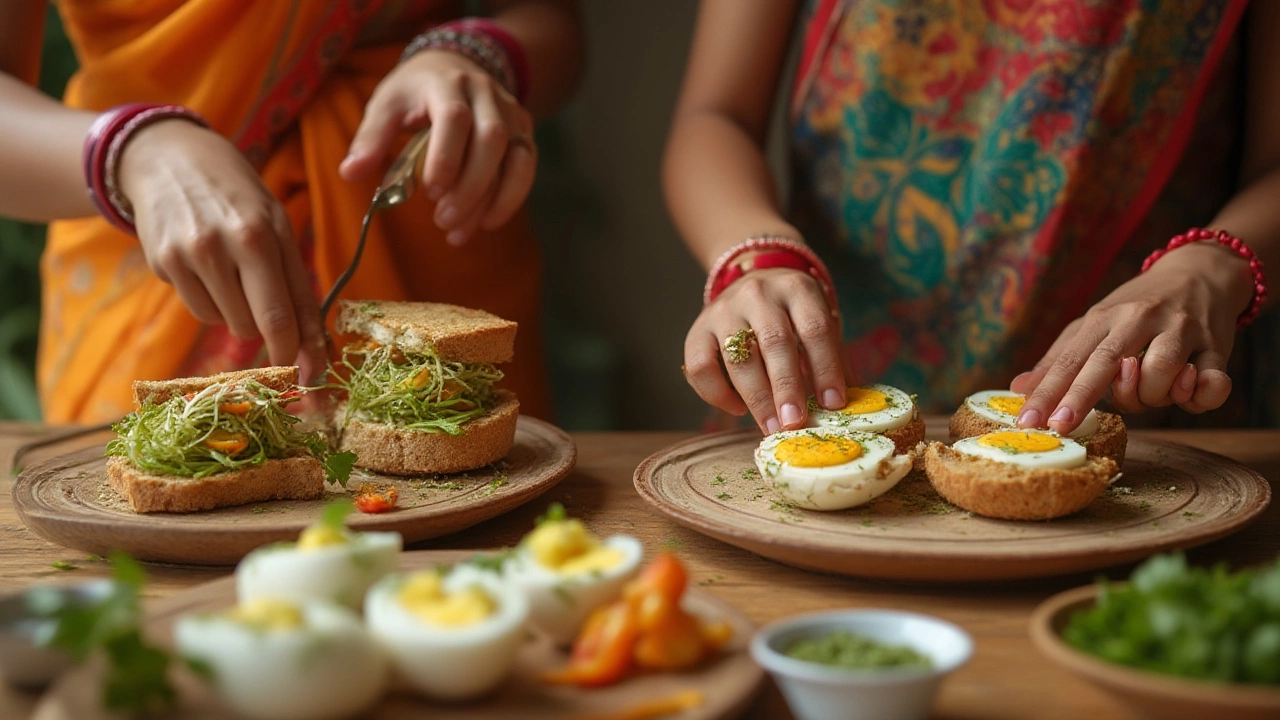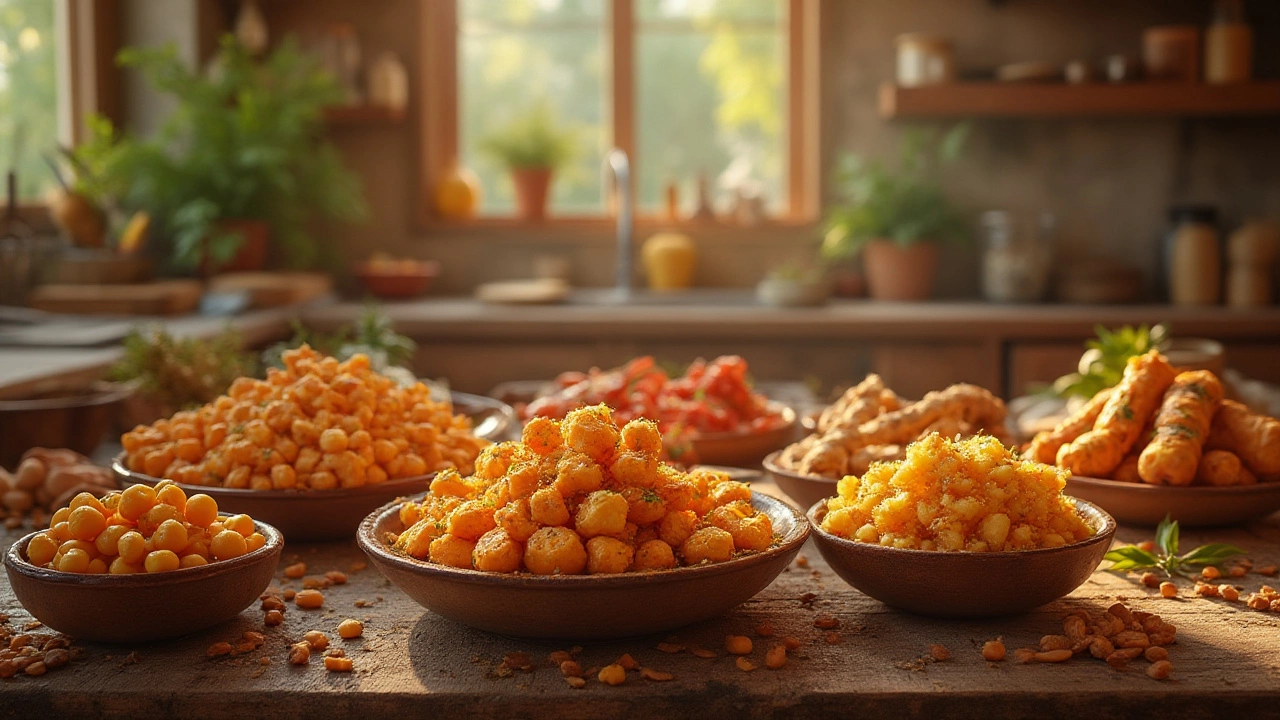Protein. It’s that magic word you hear tossed around gyms and brunch tables. But when you live in a busy household or try to please hungry kids who can spot a boring snack a mile away, hitting your protein goals can feel like a full-time job. You’d think Indian snacks are all about carbs, right? Here’s what’s wild: so many beloved Indian snacks are actually stuffed (not just figuratively) with good-for-you protein—if you know where to look.
Why Go for High Protein Indian Snacks?
It’s not just bodybuilders and fitness fanatics who crave protein. As a mum, I found that my daughter Zara stays energized and focused at school when her lunch has a protein punch. Protein helps repair your body’s cells and muscle tissues, but what’s really interesting is satiety: a protein-rich snack staves off hunger longer, so you’re less likely to grab a chocolate bar at 3 PM.
Let’s talk numbers. The daily protein needs for adults sit at about 0.8 grams per kilo of body weight, but athletes or pregnant women might need more. Kids, especially those growing at lightning speed and always on the run, also need a steady supply. Indian snacks, thanks to centuries of smart, resourceful cooking, sneak protein into the equation with lentils, chickpea flours, cottage cheese, and seeds. There’s no need to reach for expensive powders—your kitchen already has much better-tasting options.
The secret? It’s often in the base—think about besan (chickpea flour), moong dal, urad, paneer, and peanuts. With the right recipes and tricks, you can whip up snacks that not only fill your stomach but make you proud to serve the kids (or hungry friends). Plus, unlike some processed protein bars, these are free from mystery ingredients.
Top High Protein Indian Snacks You Need to Try
Let’s get to the good stuff. Here are the superstar snacks well-known in Indian homes for their protein powers, most of which have been passed down through generations and happen to be delicious.
Moong Dal Chilla: These savory lentil pancakes are a quick fix for mornings and work as after-school snacks too. Moong dal is naturally high in protein, and when you blend it up into a batter, you get something crisp on the outside, soft inside. Each chilla packs around 7–8 grams of protein if you use just 1/2 cup of dal per serving.
Paneer Tikka: Grilled, spiced cubes of paneer (Indian cottage cheese) are basically the vegetarian answer to chicken skewers. Paneer contains 18 grams of protein per 100 grams, and marinating it in yogurt and spices only makes things better for your digestion. Serve with mint chutney, and everyone’s happy.
Besan Cheela: Chickpea flour (besan) batter, spiced and cooked like a thin pancake, gives you protein plus fiber. Besan cheela is quick—ten minutes tops—and a brilliant carrier for vegetables like spinach or carrots. One big cheela gets you about 7 grams of protein and hardly any fuss.
Chana Chaat: Steamed or boiled chickpeas tossed with onions, tomatoes, lemon juice, and spices make for a street food favorite that’s loaded with plant protein—about 14–16 grams per serving. My tip: use kala chana (black chickpeas) for an earthier flavor and even more fiber.
Roasted Chana: Dry-roasted chickpeas, found in every supermarket in India and most Asian groceries worldwide, are insanely crunchy and addictive. A handy snack that fits in a reusable snack box, these little bites clock in at 20 grams of protein per 100 grams and need no refrigeration.
Masoor Dal Tikkis: Masoor dal (red lentils) can be cooked, mashed, and mixed with spices and a hint of rice flour, then pan-fried into tikkis (cutlets). They get crispy on the outside and soft within. Each tikki can have up to 5 grams of protein—pair two or three with green chutney and you’ve got lunch sorted.
Check out how these snacks compare in protein, using average values:
| Snack | Serving Size | Protein (g) |
|---|---|---|
| Moong Dal Chilla | 2 medium | 14 |
| Paneer Tikka | 100g | 18 |
| Besan Cheela | 2 medium | 13 |
| Chana Chaat | 1 medium bowl | 15 |
| Roasted Chana | 50g | 10 |
| Masoor Dal Tikki | 3 small | 12 |
When you see it all laid out like this, it’s clear: high protein Indian snacks are a real thing, not just a trend.

Hidden Gems: Lesser-Known Indian Protein Snacks
How about shaking things up with snacks that aren’t as famous worldwide? Indian kitchens have plenty more up their sleeve.
Dhokla: This spongy snack from Gujarat is made with fermented besan or sometimes a mix of besan and urad dal. It’s steamed, so you skip the oil, and each piece carries around 3–4 grams of protein. It’s light, tangy, and soaks up chutneys beautifully.
Sundal: Down south, especially during festivals, you’ll find sundal. It’s just boiled legumes (most often black chana, green moong, or white peas) with coconut, mustard seeds, and curry leaves—a snack loaded with both protein and flavor. I make it for Zara’s school lunches, and it never comes back untouched.
Sprouted Moong Salad: Growing your own sprouts at home is ridiculously simple—you just need a jar and patience. A cup of sprouted moong has more protein than regular soaked moong, and it digests easier too. Toss it with tomatoes, cucumber, lime, and a dash of salt for a fresh, crunchy salad.
Peanut Chikki: Those sweet, nutty bars you see during Makar Sankranti? They're more than just festive treats. Made of peanuts and jaggery, a small chikki can provide 2–3 grams of protein, some healthy fats, and that satisfying crunch. I swap jaggery for honey sometimes to keep it softer for the kids.
Rajma Galouti Kebab: Kidney beans blended with spices and pan-fried—these mimic the famous Lucknowi kebabs but are fully vegetarian and gluten-free. Each patty packs a surprising 4–5 grams of protein. Serve them solo, or slide into wraps for a filling snack.
Next time you pass the Indian aisle, see what dry beans and lentils are available. Experiment with your own combos—the possibilities will surprise you.
Making Your Indian Snacks Even More Protein Rich
There are plenty of ways to boost the protein content even further if you want to get creative. Here’s how you can take regular recipes and flip them into protein bombs.
- Add nuts and seeds: Scatter roasted pumpkin, sunflower, or sesame seeds over upma, idli, or even a simple sprout salad for an extra handful of protein and healthy fats.
- Use Greek yogurt instead of regular dahi—it has almost double the protein. Swap it into raita, chutneys, or spreads for dipping your snacks.
- Try stuffing: Paneer or boiled moong dal can be stuffed inside parathas, cutlets, or even bread rolls to up the protein count (and sneak in veggies for picky eaters).
- Batter upgrade: Replace plain wheat flour with besan or add whey powder if you’re making idlis or dosas for serious protein growth.
- Don’t overlook tofu: Indians are slowly welcoming tofu, which absorbs Indian spices like a dream and brings roughly 10 grams of protein per half cup. Swap paneer for tofu if you want a vegan option.
Keeping things varied is the name of the game—rotating ingredients and trying small tweaks makes snacks less boring and more nutritious each week. I keep roasted chickpeas, paneer, and cut veggies in the fridge for last-minute snack box assembly chaos!

Quick and Easy Protein Snack Ideas for Busy Days
If your schedule reads like a Tetris game, don’t worry. Here’s a shortlist of quick, realistic snack ideas that can be whipped up in under 15 minutes (or prepped ahead):
- Ready-to-eat roasted legumes: Roasted chana, edamame, or moth beans tossed with a sprinkle of masala powder. Store in airtight jars for an instant, protein-rich treat.
- Paneer cubes with chutney: Just slice, toss with a pinch of chaat masala, and skewer for a no-effort snack platter that disappears quickly.
- Besan pancakes with grated veggies: Whisk besan, water, diced onions, coriander, and carrot, then pour on a hot pan. Cooks in less than 10 minutes and works for both breakfast and evening tea.
- Egg bhurji (spiced scrambled eggs): If eggs are part of your diet, whip up a masala scramble with onions, tomatoes, and chilies. Two eggs give 12g protein, more with paneer sprinkled on top.
- Hummus with whole wheat roti slices: Not strictly Indian, but chickpeas are, and this combo is perfect for kids’ lunchboxes and picnics.
I always pack Zara’s lunch with a rotation of these, and her teachers often ask what those amazing smells are! The fresher the ingredients, the tastier (and healthier) the result. No need for fancy kitchen gadgets—just smart pantry staples and a willingness to experiment.
